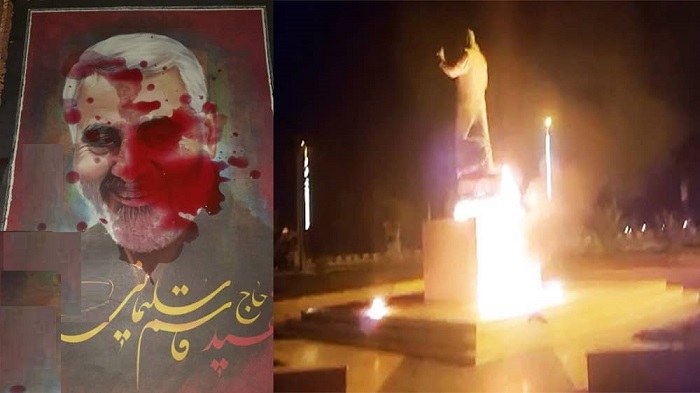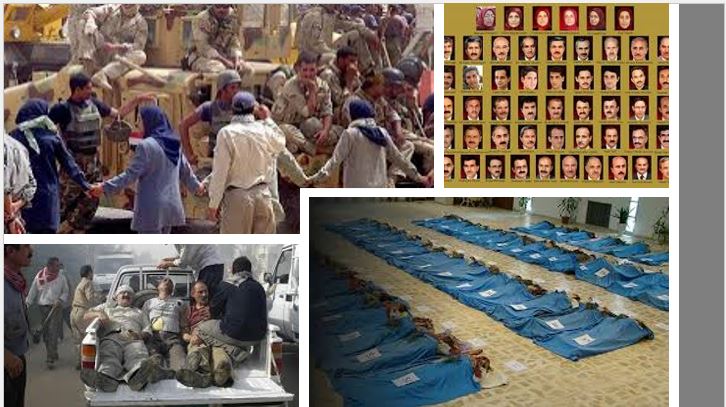
The Islamic Republic of Iran’s ruling theocracy has announced a week-long memorial for its assassinated terror mastermind, Qassem Soleimani. Tehran requires this circus as a hollow show of power as it is desperate and vulnerable in the face of the nationwide uprising, which is now in its fourth month.
But who exactly was Soleimani?
In a nutshell, Soleimani embodied Iran’s genocidal regime: a ruthless criminal with a bloody track record. He became a symbol of the mullahs’ intimidation, terrorism, and murders in Iran and around the world. Soleimani rose quickly through the ranks of the regime due to his loyalty and brutality in carrying out Tehran’s doctrine of establishing a “global Islamic state.”
Soleimani also oversaw a network of corrupt politicians. Tehran required a puppet government in order to easily expand its power in the region and, more importantly, to settle the score with the People’s Mojahedin of Iran (PMOI/MEK), the mullahs’ archenemy that was based in Iraq until 2016. The government of Iraq’s then-Prime Minister imposed a siege on the camps Ashraf and Liberty, which housed MEK members, and attacked unarmed residents, killing 141 and injuring over 1,500. Soleimani also orchestrated and carried out the “Camp Ashraf Massacre” on September 1, 2013.

The attack resulted in the execution of 52 defenseless MEK members. Seven more people, including six women, were kidnapped. Even after nearly ten years, the fate of the MEK hostages is unknown.
Soleimani’s crimes were not confined to Iran. Since the 1990s, he has been actively involved in suppressing nationwide uprisings in Iran. “During the 1999 and 2009 seditions, Haj Qassem was on the streets fighting anti-revolutionaries and taking effective measures to contain insecurity and riots,” acknowledged Mohammad Ali Jafari, former IRGC commander-in-chief, on Twitter on February 12, 2020. Soleimani’s forces were also used to put down nationwide uprisings in 2018 and November 2019.
On January 3, 2020, a US-led airstrike targeted a convoy leaving Baghdad International Airport, killing Soleimani and dealing Khamenei and his regime an irreparable blow. Along with making a big deal out of their “harsh vengeance,” Iranian officials launched a massive disinformation campaign to portray Soleimani as a “national hero.” His images cover every wall in Iran, and the regime mobilized its forces to attend his funeral.
#Iran Regime’s Official Acknowledges Qassem Soleimani’s Role in Killing Coalition Forces in Iraq
Head of a front organization of IRGC has revealed how #Iran’s eliminated terror master Qassem Soleimani “used IEDs to kill #US forces in Iraqhttps://t.co/iIuZp0oUQJ pic.twitter.com/gCAncqhpMr— NCRI-FAC (@iran_policy) January 4, 2021
The footage of the state-staged circus was used by regime apologists abroad to push the regime’s narrative that Soleimani was indeed supported by Iranians, and sadly, some international outlets bought this blatant lie wholeheartedly.
Their delusion, however, did not last long. Protesters gathered in the aftermath of the IRGC’s downing of a Ukrainian airliner tore down Soleimani’s posters. This was the reality that Tehran’s pundits attempted to hide. Indeed, following Soleimani’s death, Iranian, Iraqi, and Syrian societies were overcome with joy and jubilation. And today, Protesters across Iran are torching his images and symbols on a daily basis.
MEK Iran (follow us on Twitter and Facebook), Maryam Rajavi’s on her site, Twitter & Facebook, NCRI (Twitter & Facebook), and People’s Mojahedin Organization of Iran – MEK IRAN – YouTub

